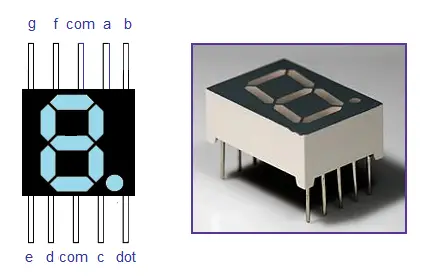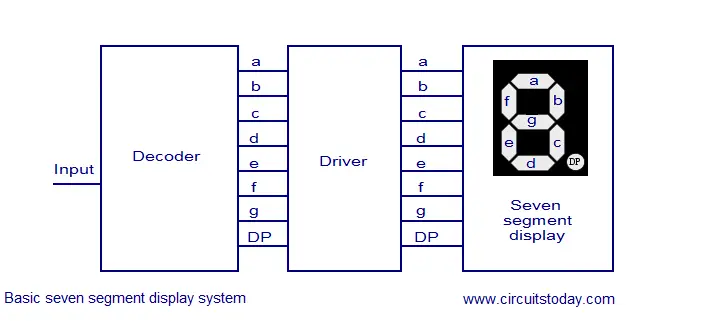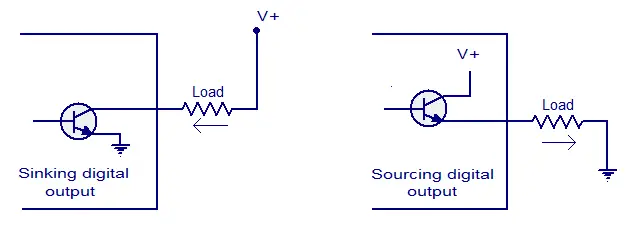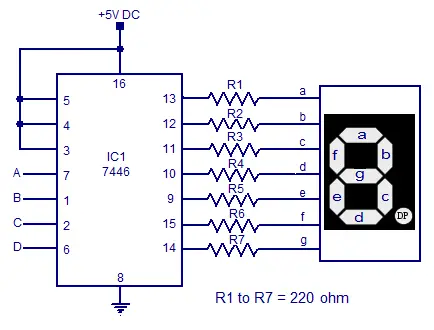7 segment display.
Seven segment display is a device that can display decimal numbers and are widely used in electronic clocks, electronic meters, digital display panels and a hand full of applications where numerical data is is displayed. The idea of seven segment display is very old and they are in the scenario from early nineteenth century. Seven segment display have seven segments which can be individually controlled (ON/OFF) to display the desired number. Numbers from 0 to 9 can be displayed using various combinations of the segments and in addition to this the hexadecimal letters A to F can be also displayed using a seven segment display. The seven elements (segments) are arranged in the form of a square shaped “8” which is slightly inclined to the right. The slight inclination to the right is given to improve the readability.Some seven segment displays have an additional dot element which can be used for indicating decimal points. The segments may be based on incandescent bulbs, fluorescent lamps, LCD or LED. Here in this article we give stress to the LED seven segment display.
In an LED 7 segment display, as the name indicates the 7 segments plus the dot segment are based on LEDs. When power is given to a particular segment, it glows and the desired digit can be displayed by powering the suitable combination of LEDs. LED seven segment displays are of two types, common cathode and common anode. In a common cathode display, the cathode of all LED segments are tied together as one common cathode pin and the anode terminals are left alone as input pins. In this scheme the common cathode is always connected to ground and the control signals (active high) are applied to the inputs (anode terminals) .In common anode type display, the anodes of LED segments are tied together as one common anode and the cathode terminals are left alone as input. In this configuration the common anode is always connected to a suitable positive voltage and the control signals (active low) are applied to the inputs (cathode terminals). Pin out and image of a seven segment display is shown in the figure below.

Basic LED 7 segment display driver system.
The block diagram of a basic LED seven segment display system that can display a given input in numerical form is shown below.

The decoder block converts the given input signal into an 8 line code corresponding to the ‘a’ to ‘g’ segments and the decimal point which controls the segments to display the desired number. For example if the line corresponding to ‘f ‘and ‘e’ are activated then segments f and e of the display glows indicating a “1”. If the input quantity is an analogue signal then it must be converter into digital format using an ADC before applying to the decoder. If the input signal is digital then there is no need for the ADC and the decoder alone will convert the particular input code into the 8 line code compatible to the seven segment LED display. The purpose of the driver stage is to provide the necessary current drive in order to drive the LED seven segment display. If the decoder stage is powerful enough to drive the display, then the driver stage is not required. A typical 7 segment display driver stage consists of an array (8 nos ) transistor or FET based switches. For example consider the line ‘a’ . The “a” output of the decoder is connected to the input terminal (base/gate) of the corresponding switching element inside the driver stage. The same line is buffered by the switching element and is available as output line ‘a’ of the driver. This output is connected to the corresponding ‘a’ element of the display. The driver can be arranged in sinking or sourcing mode.
Sinking and sourcing digital outputs.
A sinking digital output keeps the particular output low by using a transistor and thus makes a path for the load current to flow to the ground. Here the current flows from the load to the respective output terminal. In sourcing mode the the particular output is held high using a transistor the output line itself provides the necessary current for energizing the load. Here the current flows from the output terminal to the load. The figure shown below illustrates it.

In case of the sinking digital output the current comes from the external power supply V+ , passes through the load, and the internal transistor conducts it to the ground. For a sourcing digital output the current comes from the digital circuits own power supply V+, then conducted by the transistor , passes through the load and then to the external ground.
Seven segment decoder / driver.
Seven segment decoder / driver is a digital circuit that can decode a digital input to the seven segment format and simultaneously drive a 7 segment LED display using the decoded information. What that will be displayed on the 7 segment display is the numerical equivalent of the input data. For example a BCD to seven segment decoder driver can decode a 4 line BCD ( binary coded decimal) to 8 line seven segment format and can drive the display using this information. For example, if the input BCD code is 0001, the display output will be 1 , for 0010 the display output will be 2 and so on. The circuit diagram shown below is of a BCD to seven segment decoder / driver using 7446 IC.

7446 is a BCD to 7 segment display driver IC with active low outputs. The IC is stand alone and requires no external components other than the LED current limiting resistors. All output of the IC have complete ripple blanking and requires no external driver transistors. There is also a built in lamp test function which can be used to test the LED segments. Pin 5 of the IC is the ripple blanking input (RBI) and pin 4 is the ripple blanking output (RBO). Pin 3 is the lamp test (LT) input pin. When the RBI and RBO pins are held high and the lamp test (LT) input pin 3 is held low all LED segment output goes high. The display used here must be a common anode type because the IC has active low outputs.

14 Comments
how to check the seven segment display A common ANODE or Common CATHODE that i bought can u please suggest please……………
very good and explicit
i like that
how to design a LED seven segment decoder
The decoder itself consists of a large number of components. The logic circuit required to switch the ‘a’ line is: Y Y’W Y’ZX Z’W’X’, where W,X,Y, and Z are the BCD inputs.
Implementing that circuit via individual components requires 4 transistors and 11 diodes. So it’s a better idea to just use the decoder ic.
There will be a (plus sign) in the places where there are spaces in the logic circuit I gave. The plus wouldn’t upload.
hello sir/madam ,please tell me how led display and 5v can be connect without using cecoder .any simple way to connect this …
circuit with 7446 does not work 🙁
Hello circuitstoday,
your are number one.All your topics are so simple and wonderful to build and very soon you will see my own circuit upload on your site.
best regards,
Gyampoh-s.
Dis is quite helpful,thanks